Clark Field Memories
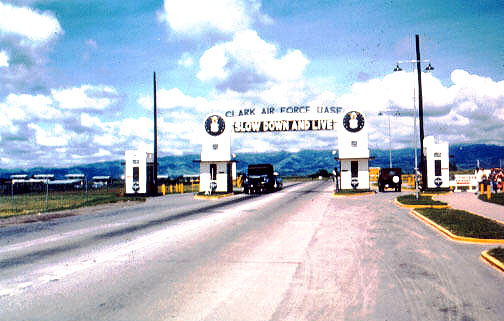
“This may not all be true, but it is my story.”
Carl Jung
Getting there
The Philippines changed my life even before I got there (and by a curious coincidence, I was born on the day in August 1946 that the Republic of the Philippines was proclaimed by President Harry Truman). Dad had been sent to Clark in November, 1958. Initially, we were all going to go together, but we got bumped by somebody. The next month, the rest of us had to go to Luke AFB near Phoenix to get shots for tropical diseases. When we got our first typhoid shots, I was the only one in the family that did not have any side effects. A few weeks later, I took the second typhoid shot and did have a side effect – I was in a coma for more than a week. I went to the base hospital just before Christmas, 1958. The next thing I knew, I was watching the Rose Bowl Parade, in a long ward filled with sick airmen. Mom swears that my little brother Sammy got out of shots by running out of the line when nobody was looking – he had the right idea.
We moved out to Clark the following April. We were one of the last families that had to make the trek on propellor-driven airplanes. The trip from San Francisco to Clark lasted 36 hours of almost non-stop flying (due to the earth’s rotation, four fifths of the trip was at night). On the way to Hawaii, the crew was nice enough to let me up into the cabin (this was before the days of plane hijackings), where I got a wide-angle look at the ocean ahead. I was impressed that the ocean waves, which look entirely random from sea level looked like a orderly patchwork from the sky. We got box lunches at each of the stops, but the nicest was the one from Hawaii that included pineapple and candy bars. I fell in love with Hawaii then, but it would be 23 years before I really saw it. At Guam, my brother Sammy went into a gift shop and bought a Major’s insignia, which he pinned on to his cap. These lasted until we landed at Clark and my Dad saw it – a serious breach of military protocol.
First impressions
We lived off-base in the Mountain View housing area for the first 6 months or so. At night you could look out to Mount Aryat and see guns going off all the time, as the government troops at the base of the mountain held a dialog with the Huks at the top of it. Huks, if I recall correctly was short for Hukbalahap – a tribe that didn’t mix well with its peers. They were said to be communists, but considering the times, you had to take that with a grain of salt.
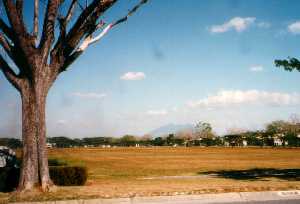
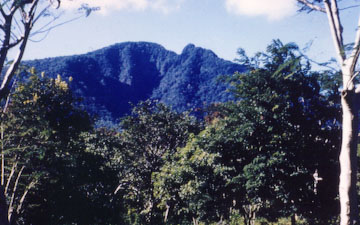
In case you wondered what Mt. Arayat looks like from its base…
We had arrived in the Spring of 1959, right in the middle of the Easter activities. I remember being alone in the house with other kids one night, looking out the window and seeing a large circle of torches. The next time you looked out there were none. Then they were back..pure terror.
In succeeding nights, the torch ceremonies were replaced with parades – each night more elaborate and with more floats. It culminated in the famous Good Friday celebration. Some Filipino men had their backs cut with razors, and they marched down the streets beating the wounded area with bamboo cords to enhance the bleeding. A smaller number (the ones who really had some repenting to do?) were lashed to crosses.

Mountain View
The area around Mountain View was a magical thing for kids who had lived in Arizona their entire lives. Our house was right next to rice paddies, where water buffalo roamed leisurely through the fields looking for grass to munch. More fierce looking were the black and tan brahma bulls. Eventually, we worked up the nerve to ride on the buffalo, at the urging of a Filipino boy named Tony who took care of the animals. Sure enough, the animals were as docile as sheep. Only Tony was bold enough to ride the brahmas.
Just past our street there was, incongruously, an enormous Baptist church.
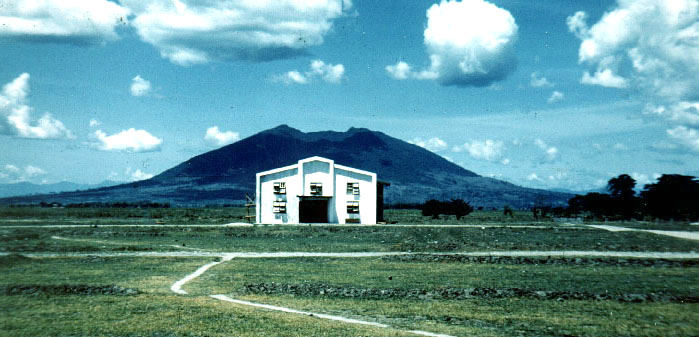
I remember that the preacher would be thundering out the gospel in evening sessions with curious Filipinos hunched over, looking in from the outside at every window. Still, the prevailing religion was a blend of 80% Catholicism and 20% whatever they had before. In contrast to the Baptists off base, the chaplain on base was clearly a Methodist. Reverend Matheson was just too nice to even consider the possibility of hellfire and brimstone.
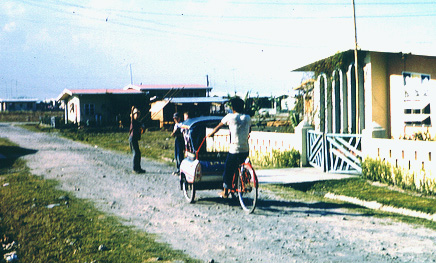
The dirt roads were full of strange and colorful new vehicles.
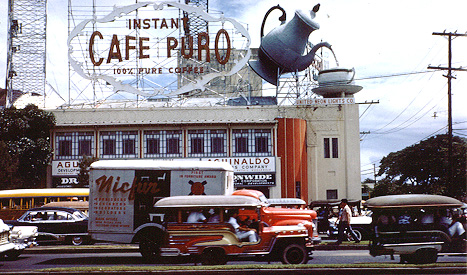
There were horse drawn carts called Calesas, human-powered pedicabs, and chrome-plated vehicles of all shapes and sizes generally known as jeepneys. It was believed that most of these jeepneys were once U.S. government property and that they were unwittingly surplused to the Filipinos. There was a story going around the base that a band of natives had the audacity to steal a fire truck right out of the station and run it out the gate with lights flashing and sirens blaring. It is said that halfway out, they were spotted by air policemen who gave them a police escort out the gate and into anonymity. This was likely the Clark version of an urban legend, because it was recounted by nearly every Clark veteran I talked to, no matter which decade they lived there.
At the Mountain View facility, we were ‘guarded’ by military-looking natives armed with rifles. It was believed that this protection was somewhat compulsory. One story said that a family was a day late in their vacation, allowing their security contract to expire. At the stroke of midnight they were cleaned out, with the former security guard loading the truck.
Just across the street from us was a row of native nipa huts. My parents said that the dogs outside never got very old, because the Filipinos treated them as domestic animals in more ways than Americans would – they ate them. This might seem unnecessarily harsh on the natives, but I saw a PBS special that confirmed that aspect of their diet. A reader of this page told me that the practice has since been outlawed. Another legendary Filipino staple was the balut – a duck egg that was fertilized and then lightly cooked just before hatching. Then the delicacy would age – the longer it aged, the more valuable. Other local specialties were enthusiastically adopted by the Americans. Lumpia was a Philippine adaptation of the egg roll – most similar to what our Chinese restaurants call Spring rolls. Early in my stay at Clark, there was a gathering in the picnic area behind Wurtsmith school where several whole pigs were barbequed in the Philippine fashion in pits buried in the ground and covered with charcoal. The first local food that we actually tried was sugar cane, which was growing in fields just a block away. It was something of a disappointment – it looked like bamboo. It was reedy, and you had to spit out most of it. The sweet flavor that you got was about half as intense as watermelon.
Milk. I can still taste that reconstituted (we called it regurgitated) milk from the first day I poured it over a bowl of corn flakes. Ugh. Like everyone else, I ordered a large glass of milk when I landed in San Francisco after our time on the island. Soft drinks were cheap and bought by the case. They, too were reconsituted but it was less noticeable, except that they were more sugary than normal. The adults could get a variety of American beers, but everybody drank San Miguel.
Mountain View even had recreational facilities of a sort. There was a privately run park at one end of the development with a pond in the middle of a dense jungle landscape. There were one or two rowboats to rent. The local sari sari stores were the Philippine equivalent of convenience markets.
Between Mountain View and the town of Angeles (A big, bustling overgrown village with one disfunctional traffic light), there was a busy establishment called the Bamboo Hut. We didn’t have to wonder what the women there did when they weren’t playing volleyball out front in their starched white uniforms (they wore large numbers on their backs for convenience sake) – the other kids told us that.
We were told never to go to the barrio, except during the Easter events. However, our maid Honora invited me and my brother to spend the night with her family, and I accepted. We rode out in an open-air bus. The two things I remember most vividly were the dinner of fish heads and rice (although they fried me up a few pieces of chicken – I still feel guilty) and the bathroom facilities which consisted of a pit below their patio. On another day, Honora’s husband Max took me to Angeles and we saw a Japanese Starman movie with subtitles in two or three languages, none of which was English.
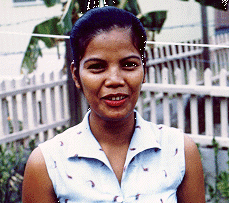 Honora – our first maid
Honora – our first maid
The weather there ranged from hot and muggy in the summer to warm and muggy in the winter. When you opened a box of corn flakes, you would have a few minutes to eat them before they started to turn soggy from the ever-present humidity. I think the constancy of the warm weather along with the lack of air conditioning slowed people down – it was like living in a Tennessee Williams play.
Clark was on a high plateau, so typhoons didn’t usually make it to the base, although several tried when I was there. There were three levels of typhoon warnings, and the first time we got a level one, my parents followed the rules and tied all of the furniture up in the center of the living room. I was disappointed that the storm was not wild enough to send us out as refugees to an emergency shelter. My parents remember this, however, as a severe storm that sent water right up into the house.
When we got to Clark, songs by the recently departed Buddy Holly were all over the Filipino radio stations. Americans got the newest popular hits at the BX after about a four month delay. The first song I remember there was ‘Itsy bitsy teenie weenie yellow polka dot bikini.’ I also remember Wurtsmith students at the adjacent snack bar singing ‘Waterloo,’ keeping rhythm by banging their Pepsi bottles on the counter.
Another monster hit that arrived during our stay was ‘El Paso,’ by Marty Robbins. My mother, Flossie, had grown up with Robbins in Glendale, Arizona. When he was starting out as a club singer, he would interject “Hello, Flossie” into whatever song he was singing when my parents entered the club. My brother and I saw him perform at the Arizona State Fair in 1958, and he made a big fuss over us when we saw him backstage and told him who our parents were. They wrote him from the Philippines to congratulate him on his new level of success, but never heard from him again.
The Scout Jamboree
As soon as we got to the Philippines, I joined the Boy Scouts, because I had been in the troop in Phoenix, rising to the rank of Second Class scout. The leader was a sergeant who had married a Filipina, and he was planning on staying there the rest of his life. His name was Mr. Franklin. Right after I joined, we were lining up for a big Memorial Day ceremony at the base cemetery near the entrance gate. It was a bright hot day, and during the ceremony, a number of the scouts passed out from the heat. Strangely, I didn’t. As an Arizona kid, I was used to heat.
Afterwards, we drank multiple bottles of soda, and wandered around the graveyard. The saddest part was seeing the section for babies who died a few days after being born.
We went to the Boy Scout Jamboree that first year, when the Philippines was hosting 12,000 scouts from all over the world – it was only the tenth world jamboree, and the first to be held in Asia. I remember five days of living in mud. We ate water buffalo steak which looked like grey shoeleather. At least it was more or less digestable. The same could not be said for the green coconuts we tried. The next day, there was a dysintery epidemic of biblical proportions.
A staff sergeant was sent along to cook for us, and he couldn’t believe the sight of kids who could not crack an egg. “I fear the day when these kids have to fight a war,” he said. I wonder if he remembered that statement five or ten years later.
We didn’t have to wait for a war – the boy scouts started one of their own, as day after day of rains turned the camp into a giant mud pack. Wooden ladders were laid down so the scouts could walk from one tent to another, but eventually, even the ladders were overwhelmed with mud. The cabin fever got to a few of the scouts one day – one boy stabbed another in the face with the tip of a flagpole, resulting in several stitches and a quick trip back to Clark.
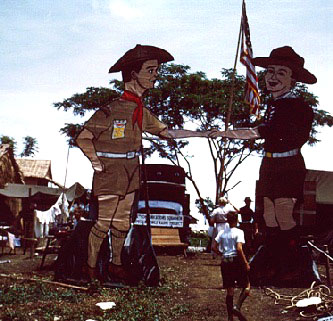
The only dry spot in the scout jamboree was the giant swimming pool which was being built for the occasion. It was running a bit behind schedule, and I never found out if they went ahead and finished it after the event.
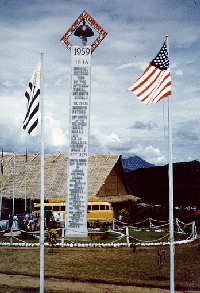
One night, we marched to the main pavilion to see a lengthy session of native dancing – the women wore long pastel dresses with butterfly sleeves – very colorful but ten minutes of it would have done for me. It was said that the President of the Philippines, Carlos Garcia, was in the stands. Garcia was famous for his ever-present smile, which found its way to the cover page of the Manila Times virtually every day (rumors were that he had prospered nicely as president and had lots to smile about). On the way back, I bought some kind of dessert (a flan of some sort on a stick).
The better scouts like my friend Harold Wilson were invited to visit the estate of a rich sugar magnate (it might have been Marcos). They were impressed with the signs of extreme wealthy like the private bowling alleys in the mansion.
We were encouraged to trade things with scouts from other countries. I remember that I traded something I had for a sleek stiletto knife, but I decided my parents wouldn’t like that, so I traded the knife for a model boat. The boatmaker was from the island where Magellan had been killed. The native who did the deed was still revered as a hero – I was scandalized at the thought. British scouts went around singing ‘The Battle of New Orleans’ with new lyrics and a different outcome.
There was a game that became a sensation during the scout jamboree. I forgot the name of it (later, Gary McClellan told me that it was and still is called Stratego), but it was a cross between chess and dominoes, with pieces that represented different kinds of artillery. As soon as two pieces occupied the same space, you found out what the other piece was. I brought it back to Arizona, and then promptly lost all the pieces.
There was a big dinner afterwards for the scouts and their parents at the VFW Hall. I remember that several of the speakers went past the normal etiquette at events of this sort and told the truth. I remember phrases like “this is the worst bunch of kids I’ve worked with in my entire life.” So ended my career as a Boy Scout.
On Base
After six months or so in Mountain View, we were moved to on-base housing. These houses came in two major varieties. There were fairly modern concrete ranch-style houses, not too different from what we had in Arizona. Then there were pre-war “barn” houses, made of wood and screen. These had more personality and floor space – that’s what we got.
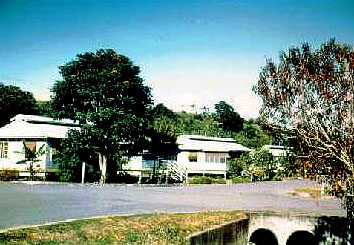
The most memorable feature of barn-house ambience was the toilet, which consisted of a tank near the ceiling and the bowl at ground level.

The houses were cleaned in two major ways. The maids would go over the wooden floors with half coconut shells treated with wax. They also swept the floors with broad, loosely strung ‘sige brooms.’ (‘sige’ is the tagalog word for ‘hurry,’ and one of the only Tagalog words we learned that was not scatalogical in nature).
Because the walls were very thin, they didn’t keep sound in or out very well. We had a neighbor, a burly paratrooper who had a long-running dispute with his wife, whose conversations were clearly audible to all of us. However, we only heard his end of the conversation. We suspected that her part of the dialog consisted mainly of “I’m sorry.”
The house was on Maverick Street, right at the bottom of Lily Hill, which then had a mushroom-shaped radar installation that they apparently took away sometime in the early 1960’s. This photo was taken around 1960:
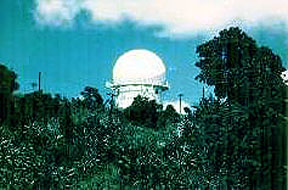
The number one activity of kids my age was collecting leftover junk from WW2. There was an active unit of the Air Force that went around confiscating the treasures that we found (a couple of kids we knew managed to smuggle a live grenade back to the states. They wanted to see what was inside, so they pried a screwdriver against it, and hit it with a hammer. It blew up in their hands, taking out several fingers). Air Police were fondly referred to as ‘Apes.’ Kids said that the dreaded EOD (Explosive Ordinance Disposal) kept a map of the airbase with colored pins showing where they confiscated their best weaponry. I was never lucky enough to make the kind of find that would get the attention of the EOD, but 50 callibre bullet heads were as common as pennies.
Lily Hill was probably the epicenter of the war remnants. It was thought to be off limits, but nobody had ever seen that in writing. We all wondered what it would be like to climb the hill, but nobody I know ever tried it, although it was rumored that a teacher found a wrecked plane up there and took the serial plate off its engine. (A reader told me that after I left, they burned off the foliage and the wrecked plane was visible to the whole world – until the EOD hauled it away)..
Most of Lily Hill was covered with dense jungle foliage, but along the ridge, there was a road leading to the domed radar installation. There is a wonderful book An annotated pictorial history of Clark AFB, edited by David Rosmer, that showed Lily Hill later on minus the radar mushroom. I also remember one expedition to a (presumably Japanese) bunker on the side of the hill.
One day, a pack of us were walking around near a blockhouse by the base of the hill, and a truck drove up. “Air Police!” one of the kids yelled, and we ran through a rough field towards our homes. Incredibly, the truck raced away to try and head us off. I took such a running dive that I landed in the dirt, spat out mud and kept going. We made it to the houses and hid out as we saw the truck drive by, with the drivers anxiously looking for us. Afterwards, our parents called the authorities to find out what was going on, but nobody admitted knowing anything about it. I imagine they were a couple of rogue EOD agents, out to harass their natural enemy. Recently, I heard from a former Air Policeman at Clark who helped to explain why they were so skittish about that hill. They had good information that a holdout Japanese soldier was still hiding out there.
One of the key features of the war culture among the boys was a constant interest in the kinds of torture that the Japanese troops used on American prisoners, the tamest being the classic “flaming bamboo splints under the fingernails.” One of the things I heard so often that it became imprinted was the phrase, “Hey, I’ve got a new torture.”
Base Facilities
Down the street from our house, at the base of Lily Hill, there was an army camp (Air force kids called them ‘Groundpounders’), a huge base swimming pool (where I took my first leap off the incredibly high diving board), and the airman’s club, which was named Coconut Grove (I didn’t really remember that- it’s in the Rosmer book).

The NCO club was called the Top Three Club. I remember that you could get an enormous stack of onion rings for 75 cents. The big social event at the Top Three was Bingo. I also remember seeing the world Hula Hoop champion – a tiny Asian girl the size and shape of a fire hydrant who could keep more than a dozen hoops going at one time in 13 different directions. At night, music was provided by Iggy de Guzman and his big band (remember, this was the fifties).
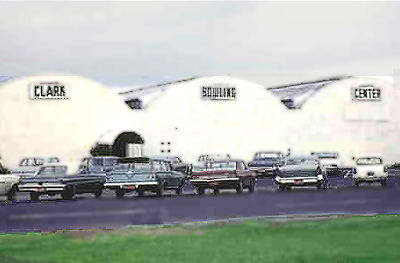
At the bowling alley (my mother’s second home) Filipino men set up the pins and you could still get a tutti fruiti milkshake for a nickel – admittedly a very small one. That picture was taken by Al Quayle in 1966, but that is just how the place looked in 1960.
Kelly theater then:
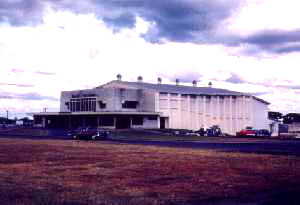
Kelly theater now, after the volcano

Movies at Kelly theater changed nearly every day, and I think admission was a quarter. Popcorn went for ten cents, a quarter, or family sized the size of a small child for 50 cents. The money you spent for these treats was always paper, because (if I remember this correctly) the only coins we had were pennies. Everything else was military scrip, including all denominations of dollars. I remember only a few of the movies – one was called “The hypnotic eye,” a really gross film about a hypnotist who gave women subconscious commands to mutilate themselves. One good film that I saw at Kelly was ‘Rio Bravo’ with John Wayne. Once my parents took us to the movies on Easter, and the theater was showing the most incredibly lame monster movie (probably an early Roger Corman effort – complete with ‘giant’ gila monsters masquerading as dinosaurs). One scene I remember vividly had a couple of men flying over the ocean in a private plane, running out of gas – ahead, there was an island that filled their window. “Hey! That’s an island!” exclaimed one of the pilots, causing gales of laughter in the theater full of air personnel. In that semi-circular row of entertainment facilities there was also a service club called the Silver Wing, and a cafeteria, also named after Kelly (Colin Kelly was a pilot who was said to have flown his crippled plane down the smokestack of a Japanese ship, although there were rumors on base that he had actually crashed into Mt. Arayat. I’m more inclined to believe the official story, although either way he died fighting for his country).
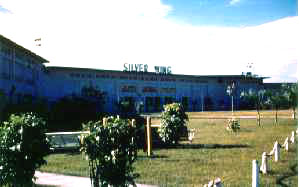
Not far from the Kelly complex, there was a base Hobby shop, with a small store, crafts facilities and a photo lab. The photo darkroom was useful for photography buffs, and it was said to be a favorite romantic spot for teenagers.
The commissary tried its best to be an appealing supermarket, even though it didn’t have any competition. Shopping for food was just about the only chore that the wives had to do, after all the other work was done by the maids and yard boys.
The Base exchange was a large building that sold everything but food. It was surrounded by a series of specialty shops. Our favorite shop was a shoe store that would put taps on your shoes for 35 cents (75 for larger horseshoe taps). This served two purposes. First, you could make a lot of noise when you walked. Secondly, at night you could scrape your shoes on the pavement and create an instant fireworks show.
We provided a bigger show one day when a group of us created a model rocket made from scraps that included a spent cardboard engine from the proper model rockets that they sold at the Hobby Shop. It was out of fuel, so we filled it with gunpowder, packing it in as tightly was we could. The fuselage was a toilet paper tube. We went to one of the concrete bases that lay exposed at the center of each block of barn houses, and lit the fuse. It sputtered out, so one of the kids held the rocket in one hand and held a match under the filled rocket engine. It exploded into a million pieces, making enough of a shock wave to blow us all to the ground. Amazingly, nobody was hurt, except for a few minor burns on the shoulder of the kid holding the rocket. Once we made sure that nobody was injured, six kids ran off in six different directions, well before the Air Police arrived to nose around the site.

The aforementioned base chapel. Even as a kid I knew that there was plenty of sin on base for three full-time chaplains to deal with.
We were there for two summers, but I don’t remember the official fireworks shows. I do remember Philippine fireworks. The most interesting thing about them was the fuse – it might burn in ten seconds, or it might surprise you and burn out in one second. We’d put the fireworks under a can and light the fuse – sending the empty can into a brief orbit. Another type of fireworks were balls that you threw at the ground, and they exploded on impact.
There was a football stadium called the Bamboo Bowl, but I don’t specifically remember any of the games there. I do remember a game that was played in Manila between the Clark All-stars and their counterparts from Formosa or Okinawa. It was a blowout against our guys. The other team actually had offensive and defensive units. Our side just had one team that did everything, but none of it very well. I think the opposing team mercifully let up before their score ran into three figures.
I signed up for the teen club the day I turned 13, but I only went for about a week. It was, to say the least, dominated by the older teens, so the chances of playing pool or playing a song on the jukebox were almost nil. The jukebox was free, so every so often one of the more aggressive older teens would just unplug it to clear past requests and then push the buttons for the songs he wanted. The signup sheet for the pool tables were handled in the same fashion.
I was only on base for one Christmas (1959), and I remember that the Christmas trees were late in coming – they arrived at the “Toyland” facility two or three days before Christmas and there were lines for blocks in the 80 degree weather.
I remember that the radio station would make announcements to a tape loop that changed between elevator music renditions of “You do something to me” and “Where and when.” Years later, my dad played a tape of this – it sounded kind of ghostly hearing about meetings and pot lucks that had occurred years ago, and 9000 miles away. Unfortunately, that tape didn’t make the transition from rell to reel
The television station played the major hit shows from the U.S. with the expected delays. The big programs were Perry Mason and Rawhide. Because the shows were timed for commercials, the base station would fill in with musical clips. My favorite was a Chaplinesque rendition of the novelty song ‘One Meatball.’ I also remember that some of my classmates (including a boy named Donald Devers) volunteered to be in a show called “Pantomime Teens,” where they acted out popular songs of the day.
Things weren’t always so good for base families. We were told that Clark dependents during the war were herded into barns which were ignited by the Japanese. Those who tried to run away were gunned down with machine guns. I never found out if that was true or not. It is certainly true that Clark was attacked almost immediately after Pearl Harbor, but only history buffs remember that. The Japanese pilots managed to catch most of our planes on the ground.
I never went to see the negrito village at Clark, but I’d heard plenty of stories about how they hated the Japanese so much during the war that they sneaked into a Japanese barracks one night and decapitated every other soldier, so that when the survivors woke up, they had dead comrades on either side. The account of negrito myth-making in the book Anything You Say Sir seems to ring a bit truer in retrospect. On the other hand, the Rosmer book shows pictures of American military men with the king of the negritos in 1919, so they were not a recent event at Clark.
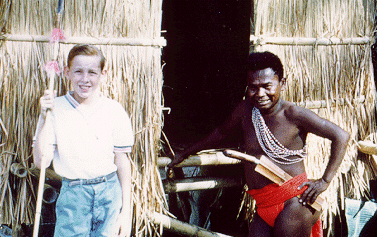
At age 9, my little brother Sammy is already taller than the King of the Negritos (He’s 6’7″ now)
Even in 1959, things were heating up in Vietnam. I remember a lot of dad’s friends being sent to Saigon to work on something. Sometimes at night, the air raid sirens atop Lily Hill would go off, and I would think thoughts of doom, but it was always a test.
Categories
- 19th Philippine Hot Air Balloon Festival in Clark
- 2012 Hot Air Balloon Festival in Clark Philippines Ticket Reservation Form Support Section
- About Angeles City, Pampanga
- About Anti-mosquito patches to prevent Dengue in Philippines
- About Asian cuisine and food of Asia
- About Clark Development Corporation CDC
- About Clark, Freeport Zone
- About Coffee
- About Easter in Clark Philippines
- About Family Bonding and Children
- About Fishing
- About Holy Week and Easter in Philippines
- About Holy Week and Easter in Philippines
- About Hot Air Balloon
- About Italian Food
- About Leisure, Stress and Relaxation
- About Mother's Day and Mother's Day Celebration
- About Nespresso Coffee, Nespresso Coffee Capsules and Pods
- About spa, places to unwind and relax
- About Subic, Baguio and Bulacan
- About the Philippines
- About the Philippines, Pampanga, Clark, and Angeles City
- About Wedding and Receptions
- Advisory and useful travel tips
- Alfresco Outdoor Dining in Clark
- All about Steaks
- All about steaks
- All News & Press Releases Archive
- Articles About Holy Week in Philippines
- Beach resorts and hotels in Clark
- Birthday, debut, baptismal, anniversary etc
- Boating and Kayaking
- Build or buy a house in Clark
- Business and investment in Clark
- Business in Clark
- Business Opportunities in Clark
- Camping and picnic
- Car and Taxi Service in Clark
- Clark
- Clark Events Archive
- Clark Flight schedules
- Clark Hot Air Balloon Festival
- Clark Hot Air Balloon Festival Complaints and Suggestions
- Clark Information
- Clark Investments Archive
- Clark Job Market Archive
- Clark Map
- Company outings and corporate events
- Condominium and Apartment in Clark
- Convenience Stores in Clark
- Corruption in Philippines, Pampanga, Subic, Clark Freeport Zone
- Culinary School in Philippines
- Doing Business in Clark
- Dormitory and Apartment Sharing
- Duty free malls in Clark
- Entertainment
- Event Venues in Clark and Pampanga
- Family outings, reunions and retreats
- Family restaurants and Fast food outlets
- Family retreat, picnics and bonding
- Fine dining Gourmet Foie Gras Cuisine
- Fine Dining Gourmet Kangaroo Cuisine
- Fine Dining Kangaroo Cuisine
- Fine dining restaurants
- Food & Beverage Archive
- Food and Beverage in Clark
- Foreigner and Tourist Assistance in Clark Archive
- Functions and events
- Games and activities for outings and picnics
- Getting around in Clark
- Getting Married in Clark and Pampanga
- Golf
- Gourmet Dining Foie Gras
- Gourmet Dining Venison Cuisine
- Gourmet Venison Cuisine
- Highly Recommended Hotels and Resorts
- Historical sites, places to see and visit
- History of Clark
- Holding a Dinner Party
- Holiday and Vacation in Philippines
- Holy Week and Easter Holiday
- Holy Week and Easter in Clark Philippines
- Holy Week and Easter Packages and Deals
- Hot Air Balloon Festival in Clark Philippines
- Hot Air Balloon Packages & Deals
- Hotel Accommodations Archive
- HOTEL and RESORTS
- Hotels & Resorts in Angeles Pampanga
- Hotels & Resorts in Clark
- Hotels and Resorts in Pampanga
- Hotels and Resorts in Philippines
- Hotels and Resorts in the North
- Hotels and Resorts near Manila
- Internet WIFI spots in Clark Philippines
- Investing in Philippines
- Investment and business opportunities
- Investment in Philippines
- Italian, French and continental cuisine
- Jobs and Careers
- Jobs in Angeles, Clark, Pampanga
- Jobs in Manila, Philippines
- Korean, Chinese and Japanese Food
- Koreans in Philippines
- Land for development
- Laws and Regulations in Clark
- Learn about wine
- Learn English in Philippines
- Leisure and recreation
- Lifestyle in Asia
- Lifestyle in Clark and Pampanga
- Liquor and Wine Shops in Clark
- Listing of businesses in Clark
- Living in Clark and Pampanga
- Manila Bus Hostage Incident 2010
- More about Holy Week and Easter Holidays
- More About Philippines Hot Air Balloon Fiesta in Clark Pampanga
- More about Weddings and receptions
- Mother's Day in Philippines
- News
- News about Hot Air Balloon
- News in Manila and North Luzon
- News in Pampanga, Angeles City, Clark, Subic
- Nightlife, casinos and entertainment
- Organizing a Cocktail Party
- Organizing company events
- Organizing Company outing
- Organizing Team Building Events
- Organizing Team Building Events
- Other restaurants, café and dining outlets
- Other shopping in Clark
- Pampanga Clark Freeport Zone or Establishment Grievances and Complaints
- Pampanga Information
- Philippine International Hot Air Balloon Fiesta
- Philippines Hot Air Balloon Festival in Clark Pampanga
- Places to go in Clark Archive
- Politics and Opinion
- Press Releases
- Product launching and marketing events
- Real Estate, Properties and Deals
- Residential village and subdivision
- Restaurants and Bars in Clark, Pampanga
- Resto Bars, Clubs and Pubs
- Resume Database
- Retirement in Clark
- Retiring in Clark Archive
- Rules & Regulations of Clark Freeport
- Safety, Law and Order in Pampanga
- Scenic spots, tourist destinations in Clark
- School Camp in Clark
- School Camp in Philippines
- Shopping
- Shopping Archive
- Short-term lease
- Sightseeing and Tourist Spots
- Social and company events planning
- Sports and outdoor events
- Sports and Recreation in Clark and Pampanga
- Sports and Recreation in Clark Archive
- Swimming and Water sports
- Teambuilding and planning
- The Clark Lifestyle
- The Green World of Clark Philippines
- THINGS TO DO IN CLARK
- Tourism and Travel
- Tourism in Clark
- Travel Accommodations Archive
- Travel agencies and airline offices
- Trekking and horseback riding
- Vacation Rental
- Vegetarian Food and Vegan Cuisine
- Vegetarian food, vegan restaurants
- Vintners' Hall of Fame
- Visit Angeles City Pampanga
- Visit Clark Philippines
- Visit Manila Philippines
- Wedding Planners, Caterers & Event Venues in Philippines
- Wedding Planning, Organization and Services
- Wedding reception Venues in Clark
- What's Happening in Clark
- Wining & Dining Archive


